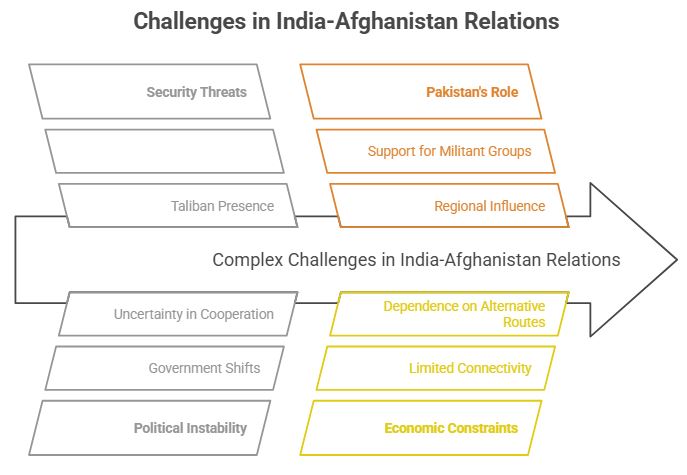It has been referred to as the "Graveyard of Empires" and has been a central player in the historical "Great Games." The Gandhar-Bharat Sambandha, also known as Afghanistan-India connections, highlights the diplomatic ties between the two countries. The Taliban takeover of Afghanistan has significant ramifications for South Asia and leaves India’s foreign-policy and security interests at considerable risk.
India-Afghanistan Relations A Quick Recap
- India and Afghanistan have a long history of cooperation, dating back to the 1950 Treaty of Friendship.
- Despite the challenges posed by the Taliban's capture of Kabul in 1996, India re-engaged with Afghanistan after the Taliban's ousting in 2001.
- India has since made significant investments and commitments, amounting to over USD 3 billion, to cultivate strong economic and defense ties with Afghanistan.
Importance of India-Afghanistan Relations for India
Economy
- Preferential Trade Agreement (2003): The signing of the Preferential Trade Agreement in 2003 led to India granting significant duty cuts, ranging from 50% to 100%, on a specific category of Afghan dry fruits.
- Initiatives in 2016: In 2016, the Prime Minister of India put forth proposals for mutual collaboration, including the supply of high-quality and affordable pharmaceuticals, as well as joint efforts in the development of solar energy. As a result of these initiatives, a second aviation route between India and Afghanistan was established.
- India has provided Afghanistan with $4 billion in development aid between 2002 and 2021.
Developmental Aid
- Zaranj to Delaram Road: A 218 km road was constructed from Zaranj to Delaram to facilitate the transportation of goods and services from Afghanistan to the Iranian border and the Chahbahar Port.
- Kabul to Pul-e-Khumri Transmission Line: Construction of a 220 kV DC transmission line from Kabul to Pul-e-Khumri.
- Salma Dam Power: Construction and commissioning of the Salma Dam power project (42 MW) in Herat province.
- Afghan Parliament: Ongoing construction of the Afghan Parliament.
- Other Assistance: India has pledged to build the Shahtoot Dam and other drinking water projects in Kabul, as well as improve road connectivity to Band-e Amir in Bamiyan to boost tourism.
- Post-Taliban Development: India received a request from the Taliban regime's foreign ministry spokesman to complete development projects. The Indian embassy in Kabul has reopened after being closed for a year.
|
Security
- A stable Afghanistan is crucial for regional and domestic security and stability for India. It acts as a buffer between India and extremist groups operating in the region.
- Afghanistan's stability is vital in countering state-sponsored terrorism emanating from Pakistan-supported groups.
- During the Fourth Regional Security Dialogue on Afghanistan, the Indian National Security Advisor (NSA) emphasized strengthening Afghanistan's capacity to combat terrorism.
Counterterrorism
- Afghanistan has been a breeding ground for terrorism, posing a threat to India's security. India has been a victim of state-sponsored terrorism supported by groups based in Afghanistan.
- A stable Afghanistan is essential for effectively countering these terrorist threats.
Natural Resources
- Afghanistan possesses significant untapped mineral resources worth around $1 trillion. These resources include minerals such as iron, copper, gold, and rare earth elements.
- Access to Afghanistan's mineral wealth can fuel India's industrial and economic growth.
Connectivity
- Afghanistan serves as a crucial gateway for India's connectivity with Central Asia. Projects like the Chabahar Port in Iran enhance India's trade and economic ties with the region.
- India-Afghanistan Air Freight Corridor: Opened in 2017 to facilitate trade and economic activities.
- Developing transport and energy corridors through Afghanistan strengthens regional connectivity and facilitates India's access to resource-rich Central Asia.
- In 2016, India signed a deal with Iran entailing $8 billion investment in Chabahar port and industries in Chabahar Special Economic Zone.

Energy Ambitions
- Afghanistan's strategic location makes it an important transit route for energy projects.
- India sees Afghanistan as a vital component of the Turkmenistan-Afghanistan-Pakistan-India (TAPI) pipeline project.
- Access to energy resources in Central Asia through Afghanistan addresses India's growing energy needs.
Strategic Influence
- India's engagement in Afghanistan helps counterbalance Pakistan's influence in the region.
- It provides a platform for India to shape the political landscape and support Afghan government stability.
- By assisting in nation-building, India safeguards its interests and prevents Afghanistan from becoming a safe haven for anti-India elements.
Challenges in India-Afghanistan Relations
- Security Threats: The volatile security situation in Afghanistan, including the presence of terrorist groups like the Taliban, poses a direct security threat to India.
- Political Instability: Political instability and shifts in government dynamics create uncertainty for sustained cooperation between India and Afghanistan.
- Pakistan's Role: Pakistan's role in Afghanistan, including its support for militant groups, remains a significant challenge for India's engagement in the region.
- Economic Constraints: Economic and infrastructural constraints, such as limited connectivity and dependence on alternative trade routes, hinder economic cooperation between India and Afghanistan.
- Humanitarian Concerns: The return of the Taliban raises concerns about human rights and the humanitarian crisis in Afghanistan, creating challenges for India's involvement.
- Regional Rivalries: Regional rivalries and power dynamics add complexity to India's engagement in Afghanistan and pose challenges to effective cooperation.
- Indian partnering with UNWFP (UN World Food Programme) for the delivery of 20,000 MTs of wheat for Afghan people through the Chabahar Port.
|
Way forward
- Strengthening Regional Cooperation: Enhancing cooperation and coordination among regional players is crucial for stability and progress in Afghanistan.
- Supporting Afghan-led Peace Process: India should support an Afghan-led and Afghan-owned peace process to achieve lasting peace and stability in the region.
- Enhancing Economic Engagement: India should focus on enhancing economic cooperation, trade, and investment with Afghanistan to promote sustainable development.
- Providing Humanitarian Assistance: India should continue to provide humanitarian assistance to address the urgent needs of the Afghan people, especially in areas such as healthcare, education, and infrastructure development.
- Strengthening Security Cooperation: Collaborating with Afghan security forces and other regional partners to address security threats and counterterrorism is essential for ensuring stability in the region.
Conclusion
India’s Afghan policy must be based on a clear-cut understanding of India’s strategic goals in the region, and the regional and global strategic environment. Though it is a bit late, yet India has taken the right decision by engaging the amenable section of the Afghan Taliban.














